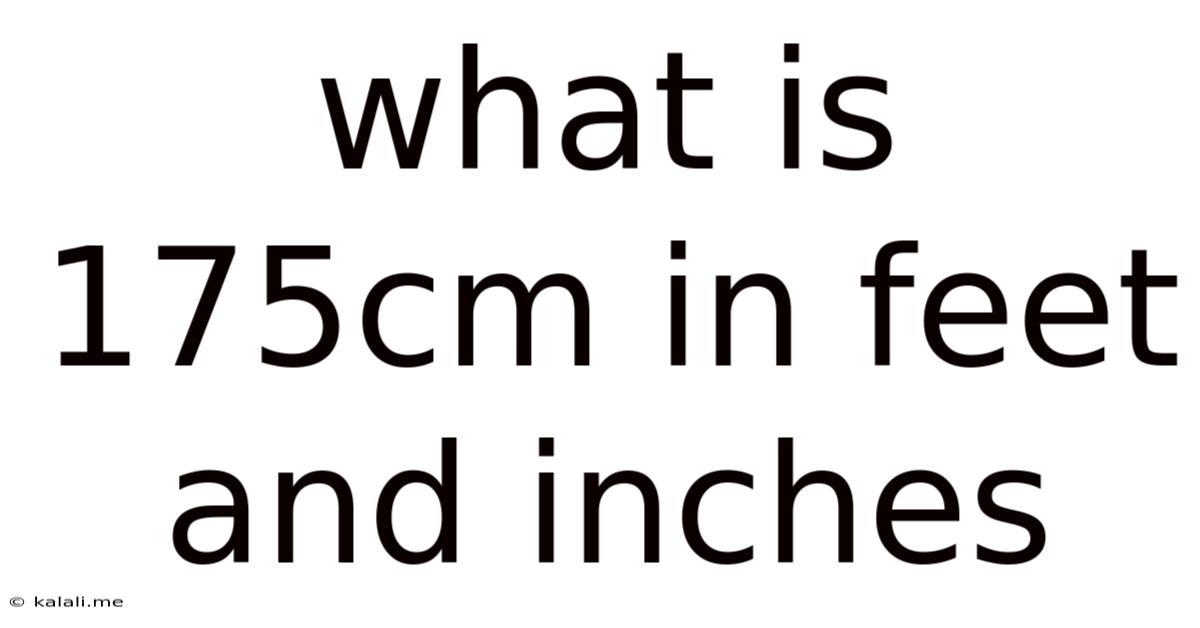What Is 175cm In Feet And Inches
Kalali
Jul 02, 2025 · 4 min read

Table of Contents
What is 175cm in Feet and Inches? A Comprehensive Guide to Metric-Imperial Conversions
Many people find themselves needing to convert measurements between the metric system (centimeters, meters, etc.) and the imperial system (inches, feet, yards, etc.). This is especially true when dealing with things like height, clothing sizes, or even crafting projects. This comprehensive guide will not only answer the question "What is 175cm in feet and inches?" but will also provide you with the knowledge and tools to perform these conversions yourself, along with exploring the context and applications of this particular measurement. Understanding the conversion process itself is key to mastering metric-imperial conversions and avoiding future confusion.
Understanding the Conversion Process: Centimeters to Inches and Feet
Before we dive into the specific conversion of 175cm, let's establish the fundamental conversion factors. The core relationship to remember is:
- 1 inch = 2.54 centimeters
This is the bedrock of all centimeter-to-inch conversions. To convert centimeters to inches, you simply divide the number of centimeters by 2.54.
Once you have the measurement in inches, converting to feet is straightforward:
- 1 foot = 12 inches
Therefore, to convert inches to feet, you divide the number of inches by 12. Any remainder will represent the remaining inches.
Calculating 175cm in Feet and Inches
Now, let's apply this knowledge to our central question: What is 175cm in feet and inches?
-
Centimeters to Inches:
175 cm / 2.54 cm/inch ≈ 68.897 inches
-
Inches to Feet and Inches:
68.897 inches / 12 inches/foot ≈ 5.74 feet
This means 68.897 inches is approximately 5 feet and 0.74 feet. To convert the decimal portion of a foot into inches, multiply it by 12:
0.74 feet * 12 inches/foot ≈ 8.88 inches
Therefore, 175cm is approximately 5 feet and 9 inches.
Practical Applications of 175cm (5 feet 9 inches)
Understanding that 175cm equates to approximately 5 feet 9 inches opens up a range of practical applications. This height falls within the average height range for adult men in many parts of the world. Knowing this conversion is valuable in various situations:
-
Clothing and Apparel: Online clothing stores often list sizes in both metric and imperial measurements. Knowing your height in both systems allows for accurate sizing when ordering clothes online, ensuring a proper fit. Understanding the implications of this height is crucial for finding well-fitting clothes. This is especially true for tailored clothing like suits or shirts.
-
Medical and Healthcare: Medical records often require height measurements. Converting between systems is crucial for accurate record-keeping and ensuring that international medical standards are consistently applied. Consistent measurement across systems is key to accurate diagnoses and treatment plans.
-
Construction and Engineering: In construction and engineering, accurate measurements are paramount for safety and structural integrity. Converting between metric and imperial units is essential in ensuring seamless collaboration between teams using different measurement systems.
-
Travel and Tourism: When traveling internationally, you may encounter measurements in different systems. This understanding becomes particularly important in navigating countries using primarily the imperial system.
-
Sports and Fitness: Height can be a factor in certain sports. For example, in basketball, height is a significant advantage. Understanding height in different measurement systems can be relevant when comparing statistics across international leagues.
Beyond the Conversion: Understanding Measurement Systems
While the conversion itself is crucial, it's also beneficial to understand the broader context of the metric and imperial systems. The metric system (also known as the International System of Units or SI) is a decimal system based on powers of 10, making conversions relatively straightforward. The imperial system, on the other hand, is based on a more complex and less standardized set of units, often leading to more intricate conversions.
Common Conversions and Helpful Tips
While we focused on 175cm, here are some other common conversions and tips to aid your understanding:
- Converting Inches to Centimeters: Multiply the number of inches by 2.54.
- Converting Feet to Centimeters: First, convert feet to inches (multiply by 12), then convert inches to centimeters (multiply by 2.54).
- Converting Centimeters to Meters: Divide the number of centimeters by 100.
- Using Online Converters: Numerous online converters are available for quick and accurate conversions. These tools can be helpful for various measurement units.
- Double-Checking Your Work: Always double-check your calculations to avoid errors, especially when dealing with critical measurements.
Conclusion: Mastering Metric-Imperial Conversions
Understanding the conversion between centimeters and feet and inches is an essential skill in today's interconnected world. The knowledge gained from this guide extends beyond the simple conversion of 175cm. It empowers you to confidently handle metric-imperial conversions in various situations, improving accuracy and efficiency in your daily life, whether you are shopping online, working on a construction project, or simply ensuring that your medical records are accurate. The ability to confidently navigate these conversions is a valuable skill that enhances clarity and precision in communication and various professional applications. Remember to always double-check your calculations and consider using online converters when needed to ensure accuracy.
Latest Posts
Latest Posts
-
Which Value Is Equal To 1 4 Of 1360
Jul 05, 2025
-
Sims Medieval How To Sic A Parrot
Jul 05, 2025
-
How Many Yards Are In 400 Feet
Jul 05, 2025
-
How Many Days Are In A Score
Jul 05, 2025
-
How Many Meters Are In 80 Feet
Jul 05, 2025
Related Post
Thank you for visiting our website which covers about What Is 175cm In Feet And Inches . We hope the information provided has been useful to you. Feel free to contact us if you have any questions or need further assistance. See you next time and don't miss to bookmark.